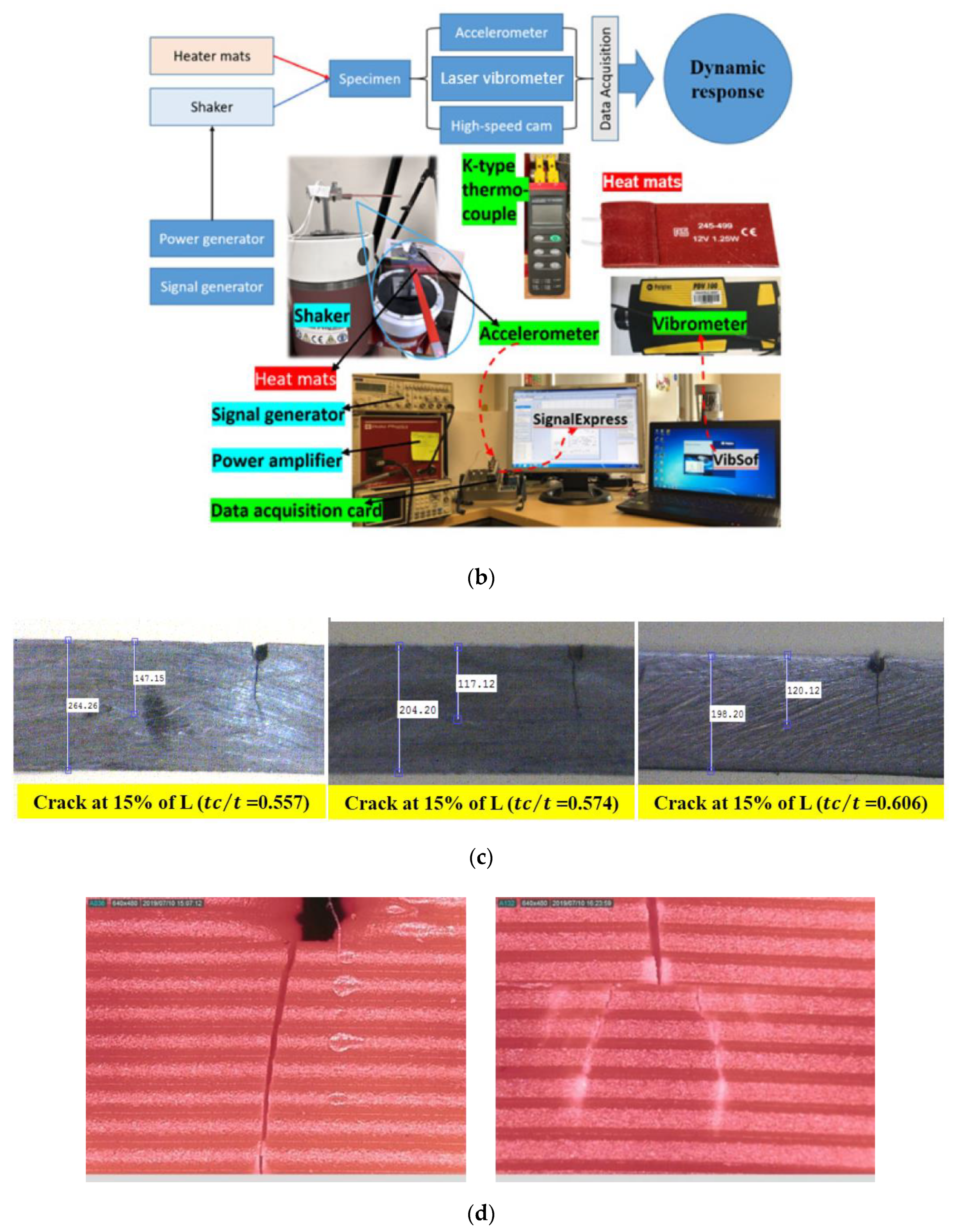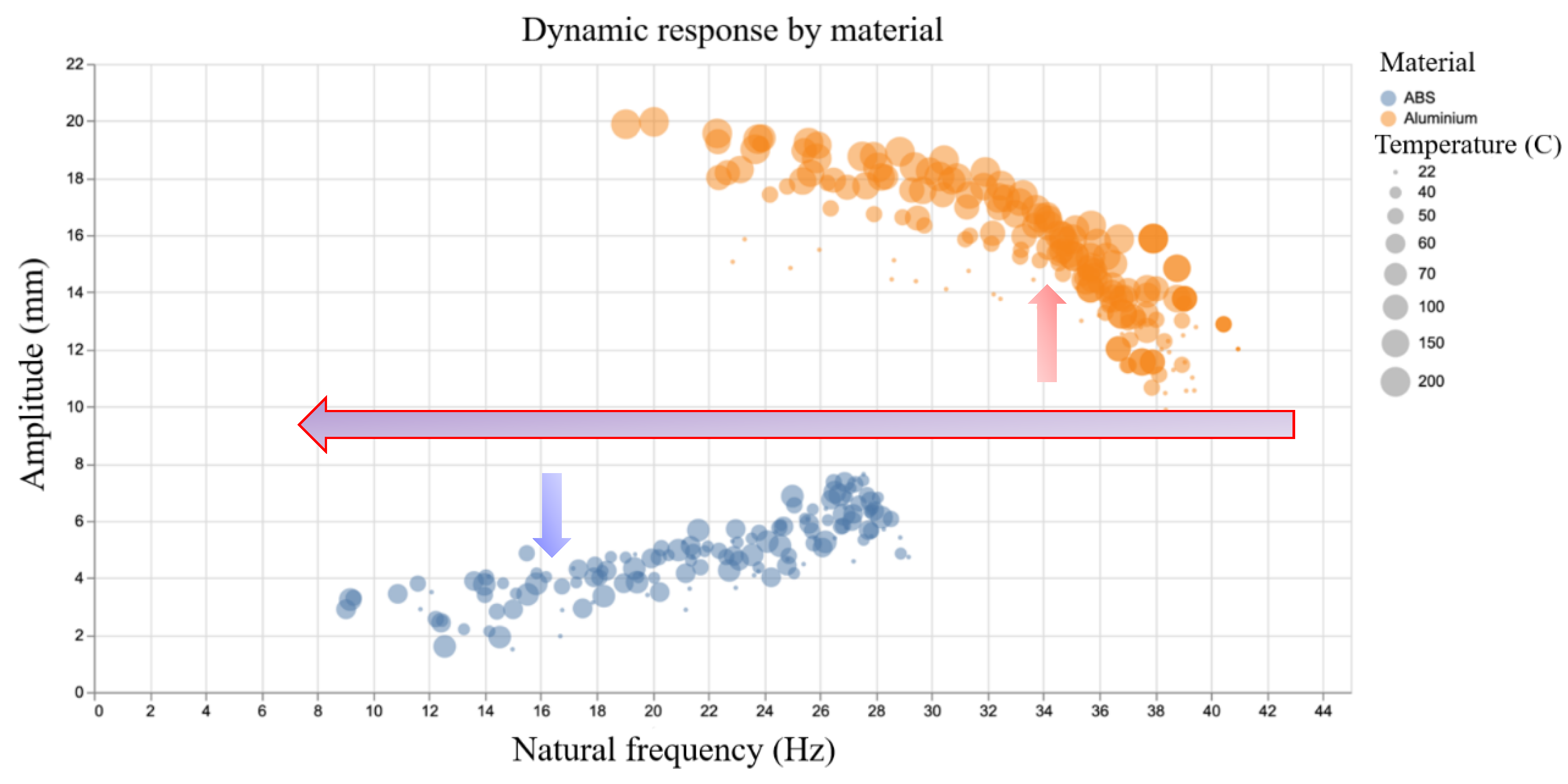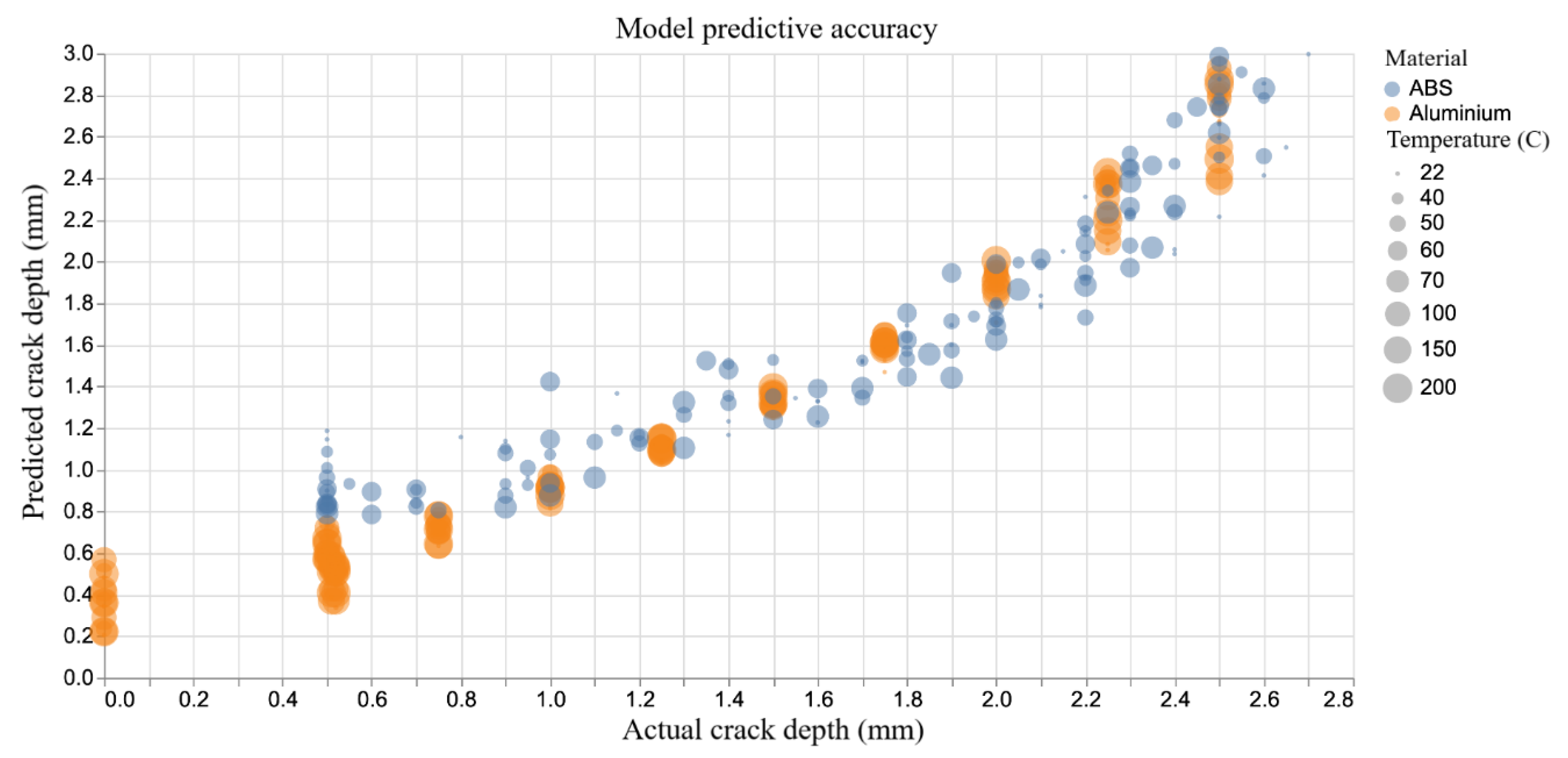A Machine Learning Approach to Model Interdependencies between Dynamic Response and Crack Propagation
Abstract
1. Introduction
2. Materials and Methods
2.1. Specimen Parameters and Experimental Data Collection
2.2. Analysis Setup
2.3. Linear Regression Modelling
2.4. Machine Learning Modelling
3. Results and Discussion
3.1. Training Data
3.2. Machine Learning Model
4. Conclusions
Author Contributions
Funding
Conflicts of Interest
References
- Riva, A.; Costa, A.; Dimaggio, D.; Villari, P.; Kraemer, K.M.; Mueller, F.; Oechsner, M. A thermo-mechanical fatigue crack growth accumulative model for gas turbine blades and vanes. In Proceedings of the ASME Turbo Expo, Seoul, Korea, 13–17 June 2016; American Society of Mechanical Engineers: New York, NY, USA, 2016. [Google Scholar]
- Rémy, L.; Alam, A.; Haddar, N.; Köster, A.; Marchal, N. Growth of small cracks and prediction of lifetime in high-temperature alloys. Mater. Sci. Eng. A 2007, 468–470, 40–50. [Google Scholar] [CrossRef]
- Pretty, C.J.; Whitaker, M.T.; Williams, S.J. Thermo-mechanical fatigue crack growth of RR1000. Materials 2017, 10, 34. [Google Scholar] [CrossRef] [PubMed]
- Kersey, R.K.; Staroselsky, A.; Dudzinski, D.C.; Genest, M. Thermomechanical fatigue crack growth from laser drilled holes in single crystal nickel based superalloy. Int. J. Fatigue 2013, 55, 183–193. [Google Scholar] [CrossRef]
- Mazanoglu, K.; Sabuncu, M. A frequency based algorithm for identification of single and double cracked beams via a statistical approach used in experiment. Mech. Syst. Signal Process. 2012, 30, 168–185. [Google Scholar] [CrossRef]
- Nandwana, B.P.; Maiti, S.K. Modelling of vibration of beam in presence of inclined edge or internal crack for its possible detection based on frequency measurements. Eng. Fract. Mech. 1997, 58, 193–205. [Google Scholar] [CrossRef]
- Gillich, G.R.; Furdui, H.; Abdel Wahab, M.; Korka, Z.I. A robust damage detection method based on multi-modal analysis in variable temperature conditions. Mech. Syst. Signal Process. 2019, 115, 361–379. [Google Scholar] [CrossRef]
- Patil, D.P.; Maiti, S.K. Detection of multiple cracks using frequency measurements. Eng. Fract. Mech. 2003, 70, 1553–1572. [Google Scholar] [CrossRef]
- Shinde, Y.D.; Katekar, S.D. Vibration Analysis of Cantilever Beam With Single Crack using Experimental Method. Int. J. Eng. Res. Technol. 2014, 3, 1644–1648. [Google Scholar]
- Revi, R.; Indu, V.S. Crack Detection of Propped Cantilever Beam Using Dynamic Analysis. Int. J. Tech. Res. Appl. 2015, 3, 2320–8163. [Google Scholar]
- Khan, M.A.; Khan, S.Z.; Sohail, W.; Khan, H.; Sohaib, M.; Nisar, S. Mechanical fatigue in aluminium at elevated temperature and remaining life prediction based on natural frequency evolution. Fatigue Fract. Eng. Mater. Struct. 2015, 38, 897–903. [Google Scholar] [CrossRef]
- Zai, B.A.; Khan, M.A.; Khan, K.A.; Mansoor, A. A novel approach for damage quantification using the dynamic response of a metallic beam under thermo-mechanical loads. J. Sound Vib. 2020, 469, 115134. [Google Scholar] [CrossRef]
- Zai, B.A.; Khan, M.A.; Khan, K.A.; Mansoor, A.; Shah, A.; Shahzad, M. The role of dynamic response parameters in damage prediction. Proc. Inst. Mech. Eng. Part C J. Mech. Eng. Sci. 2019, 233, 4620–4636. [Google Scholar] [CrossRef]
- Khan, M.A.; Khan, K.A.; Khan, S.Z.; Nisar, S.; Starr, A. Fracture life estimation of Al-1050 thin beams using empirical data and a numerical approach. Insight Non-Destr. Test. Cond. Monit. 2018, 60, 363–368. [Google Scholar] [CrossRef]
- Zai, B.A.; Khan, M.A.; Mansoor, A.; Khan, S.Z.; Khan, K.A. Instant dynamic response measurements for crack monitoring in metallic beams. Insight Non-Destr. Test. Cond. Monit. 2019, 61, 222–229. [Google Scholar] [CrossRef]
- Kameia, K.; Khan, M.A. Influence of Temperature on Fatigue Crack Growth and Structural Dynamics. In Proceedings of the TESConf 2020—9th International Conference on Through-life Engineering Services, Cranfield, UK, 3–4 November 2020. [Google Scholar]
- Das, S.; Saha, P.; Patro, S.K. Vibration-based damage detection techniques used for health monitoring of structures: A review. J. Civ. Struct. Health Monit. 2016, 6, 477–507. [Google Scholar] [CrossRef]
- He, F.; Khan, M.A.; Zai, B.A. Material mechanics of crack growth in structural dynamics. Procedia Struct. Integr. 2019, 17, 72–79. [Google Scholar] [CrossRef]
- Zai, B.A.; Khan, M.A.; Khan, S.Z.; Asif, M.; Khan, K.A.; Saquib, A.N.; Mansoor, A.; Shahzad, M.; Mujtaba, A. Prediction of Crack Depth and Fatigue Life of an Acrylonitrile Butadiene Styrene Cantilever Beam Using Dynamic Response. J. Test. Eval. 2020, 48, 20180674. [Google Scholar] [CrossRef]
- Shukla, A.K.; Janmaijaya, M.; Abraham, A.; Muhuri, P.K. Engineering applications of artificial intelligence: A bibliometric analysis of 30 years (1988–2018). Eng. Appl. Artif. Intell. 2019, 85, 517–532. [Google Scholar] [CrossRef]
- Jaanuska, L.; Hein, H. Crack identification in beams using haar wavelets and machine learning methods. Int. J. Mech. 2016, 10, 281–287. [Google Scholar]
- Ghadimi, S.; Kourehli, S.S. Multiple crack identification in Euler beams using extreme learning machine. KSCE J. Civ. Eng. 2017, 21, 389–396. [Google Scholar] [CrossRef]
- Hoshyar, A.N.; Samali, B.; Liyanapathirana, R.; Houshyar, A.N.; Yu, Y. Structural damage detection and localization using a hybrid method and artificial intelligence techniques. Struct. Health Monit. 2020, 19, 1507–1523. [Google Scholar] [CrossRef]
- Liu, H.; Zhang, Y. Deep learning based crack damage detection technique for thin plate structures using guided lamb wave signals. Smart Mater. Struct. 2020, 29. [Google Scholar] [CrossRef]
- Kourehli, S.S.; Ghadimi, S.; Ghadimi, R. Vibration analysis and identification of breathing cracks in beams subjected to single or multiple moving mass using online sequential extreme learning machine. Inverse Probl. Sci. Eng. 2019, 27, 1057–1080. [Google Scholar] [CrossRef]
- Rageh, A.; Eftekhar Azam, S.; Linzell, D.G. Steel railway bridge fatigue damage detection using numerical models and machine learning: Mitigating influence of modeling uncertainty. Int. J. Fatigue 2020, 134, 105458. [Google Scholar] [CrossRef]
- Wu, J.; Li, X.; Xu, S.; Er, M.J.; Wei, L.; Lu, W.F. Machine learning approach for shaft crack detection through acoustical emission signals. In Proceedings of the 20th Conference on Emerging Technologies & Factory Automation (ETFA), Luxembourg, 8–11 September 2015. [Google Scholar] [CrossRef]
- Gecgel, O.; Ekwaro-Osire, S.; Dias, J.P.; Nispel, A.; Alemayehu, F.M.; Serwadda, A. Machine Learning in Crack Size Estimation of a Spur Gear Pair Using Simulated Vibration Data. Mech. Mach. Sci. 2019, 61, 175–190. [Google Scholar] [CrossRef]
- Hasan, M.J.; Kim, J.M. Fault detection of a spherical tank using a genetic algorithm-based hybrid feature pool and k-nearest neighbor algorithm. Energies 2019, 12, 991. [Google Scholar] [CrossRef]
- Inkoom, S.; Sobanjo, J.; Barbu, A.; Niu, X. Prediction of the crack condition of highway pavements using machine learning models. Struct. Infrastruct. Eng. 2019, 15, 940–953. [Google Scholar] [CrossRef]
- Wan, Y.; Wu, C. Fitting and prediction for crack propagation rate based on machine learning optimal algorithm. In Proceedings of the 2009 International Conference on E-Learning, E-Business, Enterprise Information Systems, and E-Government, Hong Kong, China, 5–6 December 2009. [Google Scholar] [CrossRef]
- Karvelis, P.; Georgoulas, G.; Kappatos, V.; Stylios, C. Deep machine learning for structural health monitoring on ship hulls using acoustic emission method. Ships Offshore Struct. 2020. [Google Scholar] [CrossRef]
- Yang, J.F.; Li, Z.S.; Jiang, G.; Chen, J.F. Research of dimensionality reduction for fatigue stress concentration factor based on SVM by linear kernel. Appl. Mech. Mater. 2014, 687–691, 1649–1652. [Google Scholar] [CrossRef]
- Lu, Q.; Zhu, J.; Zhang, W. Quantification of Fatigue Damage for Structural Details in Slender Coastal Bridges Using Machine Learning-Based Methods. J. Bridg. Eng. 2020, 25, 1–12. [Google Scholar] [CrossRef]
- Guilleminot, J.; Dolbow, J.E. Data-driven enhancement of fracture paths in random composites. Mech. Res. Commun. 2020, 103, 103443. [Google Scholar] [CrossRef]
- Mousavi Nezhad, M.; Gironacci, E.; Rezania, M.; Khalili, N. Stochastic modelling of crack propagation in materials with random properties using isometric mapping for dimensionality reduction of nonlinear data sets. Int. J. Numer. Methods Eng. 2018, 113, 656–680. [Google Scholar] [CrossRef]
- Baqasah, H.; He, F.; Zai, B.A.; Asif, M.; Khan, K.A.; Thakur, V.K.; Khan, M.A. In-situ dynamic response measurement for damage quantification of 3D printed ABS cantilever beam under thermomechanical load. Polymers 2019, 11, 2079. [Google Scholar] [CrossRef]
- McKinney, W. Data Structures for Statistical Computing in Python. In Proceedings of the 9th Python in Science Conference, Austin, TX, USA, 28 June–3 July 2010. [Google Scholar]
- Van der Walt, S.; Colbert, S.C.; Varoquaux, G. The NumPy Array: A Structure for Efficient Numerical Computation. Comput. Sci. Eng. 2011, 13, 22–30. [Google Scholar] [CrossRef]
- Varoquaux, G.; Buitinck, L.; Louppe, G.; Grisel, O.; Pedregosa, F.; Mueller, A. Scikit-learn: Machine Learning in Python. GetMobile Mob. Comput. Commun. 2015, 19, 29–33. [Google Scholar] [CrossRef]
- Hunter, J.D. Matplotlib: A 2D Graphics Environment. Comput. Sci. Eng. 2007, 9, 90–95. [Google Scholar] [CrossRef]
- Waskom, M.; Botvinnik, O.; O’Kane, D.; Hobson, P.; Ostblom, J.; Lukauskas, S.; Gemperline, D.C.; Augspurger, T.; Halchenko, Y.; Cole, J.B.; et al. Mwaskom/Seaborn: V0.9.0. Available online: https://zenodo.org/record/1313201#.X8QYSWhKhPY. (accessed on 20 November 2020).
- VanderPlas, J.; Granger, B.; Heer, J.; Moritz, D.; Wongsuphasawat, K.; Satyanarayan, A.; Lees, E.; Timofeev, I.; Welsh, B.; Sievert, S. Altair: Interactive Statistical Visualizations for Python. J. Open Source Softw. 2018, 3, 1057. [Google Scholar] [CrossRef]










| Metric | Aluminium | ABS |
|---|---|---|
| RMSE | 0.176 mm | 0.256 mm |
| R2 | 0.95 | 0.86 |
| Feature | Aluminium Coefficient | ABS Coefficient |
|---|---|---|
| Natural Frequency | −0.636304 | −0.338966 |
| Temperature | −0.244674 | −0.092730 |
| Amplitude | 0.161097 | −0.281892 |
| Crack Position | 0.119964 | 0.081306 |
Publisher’s Note: MDPI stays neutral with regard to jurisdictional claims in published maps and institutional affiliations. |
© 2020 by the authors. Licensee MDPI, Basel, Switzerland. This article is an open access article distributed under the terms and conditions of the Creative Commons Attribution (CC BY) license (http://creativecommons.org/licenses/by/4.0/).
Share and Cite
Fleet, T.; Kamei, K.; He, F.; Khan, M.A.; Khan, K.A.; Starr, A. A Machine Learning Approach to Model Interdependencies between Dynamic Response and Crack Propagation. Sensors 2020, 20, 6847. https://doi.org/10.3390/s20236847
Fleet T, Kamei K, He F, Khan MA, Khan KA, Starr A. A Machine Learning Approach to Model Interdependencies between Dynamic Response and Crack Propagation. Sensors. 2020; 20(23):6847. https://doi.org/10.3390/s20236847
Chicago/Turabian StyleFleet, Thomas, Khangamlung Kamei, Feiyang He, Muhammad A. Khan, Kamran A. Khan, and Andrew Starr. 2020. "A Machine Learning Approach to Model Interdependencies between Dynamic Response and Crack Propagation" Sensors 20, no. 23: 6847. https://doi.org/10.3390/s20236847
APA StyleFleet, T., Kamei, K., He, F., Khan, M. A., Khan, K. A., & Starr, A. (2020). A Machine Learning Approach to Model Interdependencies between Dynamic Response and Crack Propagation. Sensors, 20(23), 6847. https://doi.org/10.3390/s20236847





